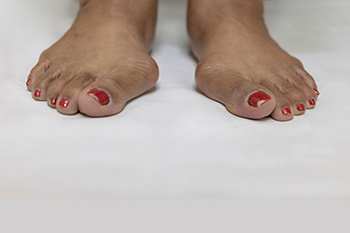
People who have bunions may be embarrassed by their appearance. It is defined as a hard lump that forms on the side of the big toe, and may gradually increase in size. It can develop for reasons consisting of genetic factors, or from wearing shoes that do not have adequate room for the toes to move freely in. A severe bunion may cause the toes to shift toward each other, and it may cause difficulty in walking. There are some patients that have corns and calluses that develop on top of the bunion, and this can happen from friction as the toe touches the shoe. If daily activities are affected, surgery may need to be performed for permanent removal. A bunion may form from existing medical conditions, including arthritis, gout, and cerebral palsy. Many people notice their skin is red and swollen surrounding the bunion, and the big toe may be stiff. If you are aware of the beginning stages of a bunion, it is strongly urged that you consult with a podiatrist who can treat this type of foot condition.
If you are suffering from bunions, contact Dr. Richard Silverstein of Union Foot Care. Our doctor can provide the care you need to keep you pain-free and on your feet.
What Is a Bunion?
A bunion is formed of swollen tissue or an enlargement of boney growth, usually located at the base joint of the toe that connects to the foot. The swelling occurs due to the bones in the big toe shifting inward, which impacts the other toes of the foot. This causes the area around the base of the big toe to become inflamed and painful.
Why Do Bunions Form?
Genetics – Susceptibility to bunions are often hereditary
Stress on the feet – Poorly fitted and uncomfortable footwear that places stress on feet, such as heels, can worsen existing bunions
How Are Bunions Diagnosed?
Doctors often perform two tests – blood tests and x-rays – when trying to diagnose bunions, especially in the early stages of development. Blood tests help determine if the foot pain is being caused by something else, such as arthritis, while x-rays provide a clear picture of your bone structure to your doctor.
How Are Bunions Treated?
- Refrain from wearing heels or similar shoes that cause discomfort
- Select wider shoes that can provide more comfort and reduce pain
- Anti-inflammatory and pain management drugs
- Orthotics or foot inserts
- Surgery
If you have any questions, please feel free to contact our office located in Havre de Grace, MD . We offer the newest diagnostic and treatment technologies for all your foot care needs.
